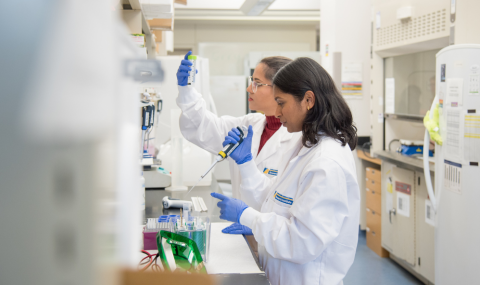Back to Cardiac Tests & Procedures
Introduction
Sometimes the cardiologist can widen a narrowed coronary artery with a procedure called coronary angioplasty.
An angioplasty is like a heart catheterization study. A catheter is inserted into an artery in the wrist (most commonly) or groin (less common). A small, balloon-tipped tube is threaded through the catheter. It is advanced through the narrowed part of the coronary artery. The balloon is inflated several times which pushes the blockage back against the artery wall. This allows more blood to flow to the heart muscle. Sometimes a tiny wire mesh (stent) is placed over the balloon and is imbedded into the artery wall. This helps prevent the blockage or narrowing from reoccurring.
Risk Factors
Your physician will discuss these with you at the time of your appointment.
What to Expect Before the Angioplasty
The Day Before Admission
You may have been given a prescription for an antiplatelet drug called Clopidogrel (Plavix) or Ticagrelor (Brillinta) to be started prior to your angioplasty. This medication is prescribed if an intracoronary stent is to be inserted during the angioplasty. Antiplatelets help prevent a clot from being formed at the site of the angioplasty.
The Day of the Angioplasty
You should arrive at the patient registration at the specified time the day of your procedure (main floor at University Hospital) to provide some general information. Bring your health card. This will take approximately 15 minutes.
When you are finished in patient registration, you will be directed to the Cardiac Day Night Unit (CDNU) or directly to the Cardiac Catheterization Lab (cath lab) where your nurse will review the procedure with you. Your family is welcome to accompany you.
You should have a list of your medications handy. You need to tell the nurse if you take pills or insulin for diabetes, if you have any allergies to medications or x-ray dye, or if you have been taking any blood thinners such as Coumadin or Warfarin.
Bring what you will need for an overnight stay. You must plan to have someone drive you home the day after your angioplasty as you will not be able to drive for two (2) days after this procedure.
You will have an intravenous (IV) started. You will be asked to sign an informed consent before you have your angioplasty. This is your opportunity to ask any questions following a description of the risks, benefits, and alternatives of the procedure. You will have an opportunity to talk to the doctor before the procedure.
What to Expect During the Angioplasty
You will arrive in the Cardiac Catheterization Lab (Cath lab) on the second floor and will be brought into one of three labs. Inside, there will be Nurses, Interventionalists and Medical radiation technologists with you. You will lay on the special table in the lab and you will receive light sedation. If you feel uncomfortable or nervous please let someone know.
During the procedure, the physician will insert a wire into your radial (wrist) or femoral (groin) artery, they will use contrast and fluoroscopy in order to visualize your coronary arteries. If there is a blockage they will deploy a stent to open the artery. When the procedure is finished they will remove the tube from your wrist and apply a clamp. If they enter through the groin, a nurse may have to apply pressure in order to stop any bleeding. You will be notified of any interventions performed.
What to Expect After the Angioplasty
After your angioplasty, you will recover in the Holding room or the Cardiac Day/Night Unit (CDNU). You will be on bedrest after the procedure. Many people are discharged the same day but occasionally, although, you may be required to stay overnight or may even be admitted to hospital depending on the findings.
Going Home
Medications are very important to prevent your stent from plugging or blocking off. Make sure you fill any new prescription for medications the day of your procedure and take them as instructed.
Upon discharge, you should consider the following things:
- You are not to drive for 48 hours after the procedure.
- Gradually return to normal activities.
- Avoid heavy lifting (over 20 pounds) for 24-48 hours.
- Avoid excessive bending at the insertion site. You may want to recline your seat on the way home from hospital if they puncture the groin site.
- Remove the band aid the day after the procedure.
- You may shower or bathe as you wish the following day.
- You may return to work within 48 hours unless instructed otherwise by your cardiologist.
Taking care of your groin site:
- Avoid excessive bending at the groin site. You may want to recline your seat to 45 degrees (about half way) on the way home from the hospital.
- Avoid soaking in baths until the puncture site is healed. You may shower, letting the water run over the site.
- You can take your bandaid off in 24 hours. It is best to do this in the shower.
- Avoid lotions and powders to the puncture site.
- If you have signs of infection (new redness, swelling, drainage at the puncture site or fever) go to your family doctor.
- It is normal to have some swelling or bruising at the groin site. If you have a bruise this may extend down your leg over the next few weeks as it heals. If you have increased pain with walking, swelling that is increasing in size, or numbness you should see your family doctor or nearest emergency department.
- If you have a small amount of blood oozing from your puncture site apply constant pressure for 5-10 minutes. If it does not stop, continue to hold pressure and go to your family doctor or the nearest emergency department.
- If you have a large amount of bleeding from your puncture site, apply constant pressure, lie down and call an ambulance and go to the nearest emergency department.
Taking care of your wrist site:
- Do not put any weight on your wrist for the first 24 hours.
- Avoid repetitive actions with your affected hand for 48 hours (typing, texting, etc.).
- Avoid soaking in baths until the puncture site is healed. You may shower, letting the water run over the site. For the first 48 hours do not immerse your hand in water.
- You can take your bandaid off in 24 hours. It is best to do this in the shower.
- Avoid lotions and powders to the puncture site.
- If your hand becomes swollen or cool to touch, go to your family doctor or the nearest emergency department.
- If you have signs of infection (new redness, swelling, drainage at the puncture site or fever) go to your family doctor.
- If you have a small amount of bleeding from your puncture site apply constant pressure for 5-10 minutes. If it does not stop, continue to hold pressure and go to your family doctor or the nearest emergency department. If you have a large amount of bleeding from the puncture site apply constant pressure, sit down, call an ambulance and go the nearest emergency department.
Follow-Up
You will receive a follow-up phone call approximately 24 hours after you go home if you receive a stent. The purpose of this call is to inquire about any questions or concerns you may be having following your angioplasty. You should make an appointment to see your family doctor within one week of discharge.



